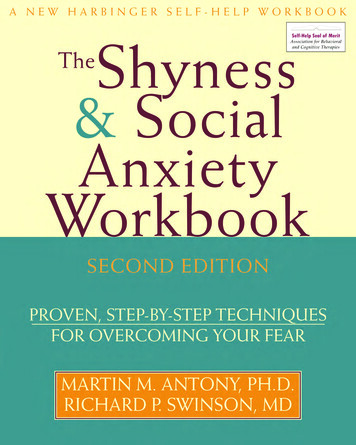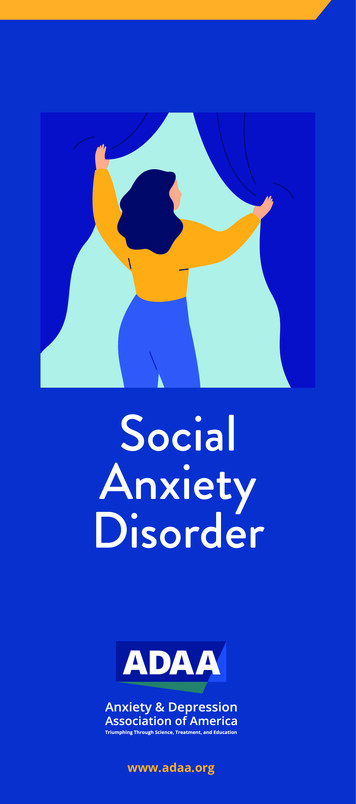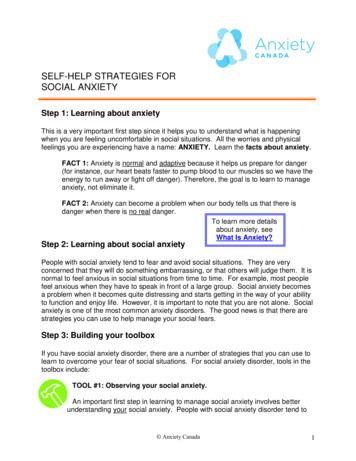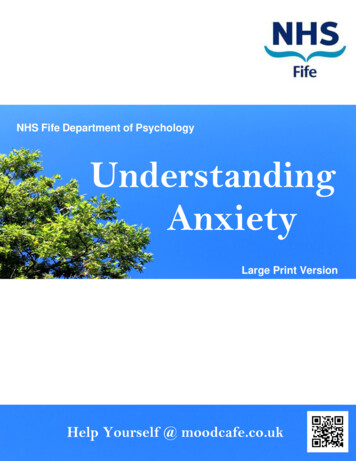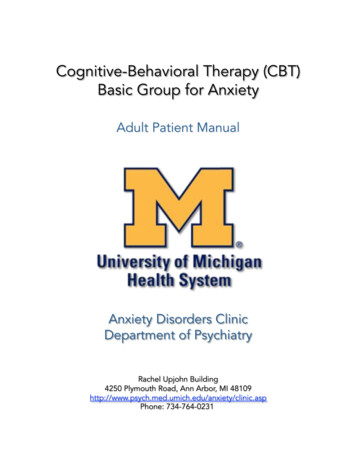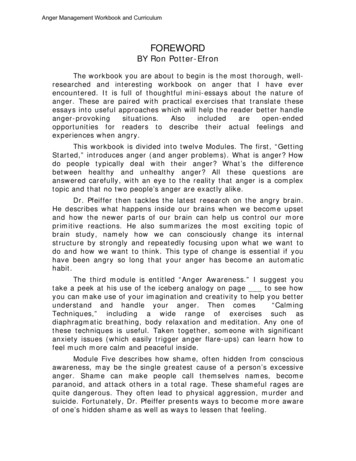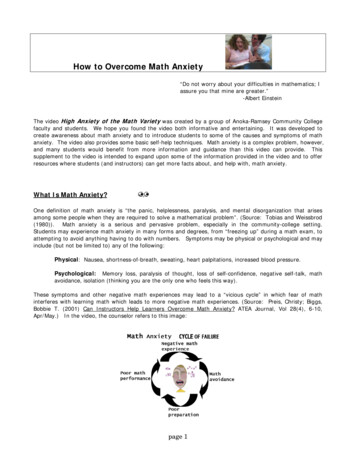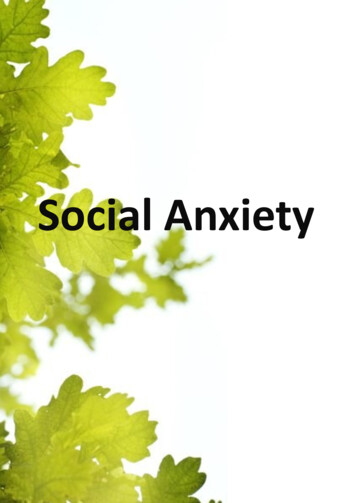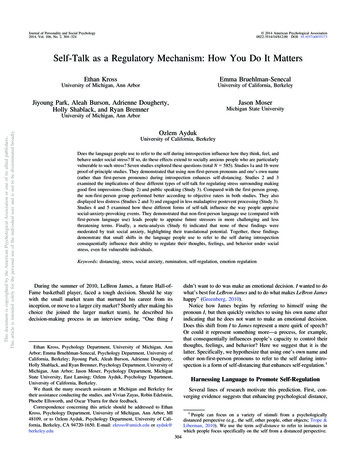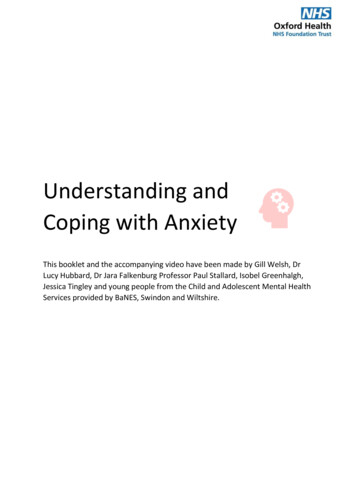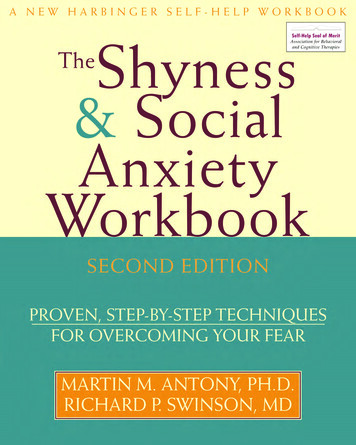
Transcription
“Social anxiety and shyness can become so intense that they prevent people from enjoying life. This book is ideal for anyone who wants to learn to be more comfortablearound other people. Drs. Antony and Swinson have taken proven treatments for socialanxiety and adapted them for a non-professional audience. The step-by-step strategiesdescribed in this book have been shown to be effective, are easy to understand, andare sure to help the reader cope better in social situations. Anyone who experiencessignificant anxiety when performing or when interacting with other people should readthis book!”— Aaron T. Beck, MD, university professor of psychiatry at theUniversity of Pennsylvania“If you have trouble with social anxiety, you will find the book by Drs. Antony andSwinson to be an excellent resource. This highly experienced duo has provided an excellent road map to guide you through your efforts to overcome your anxiety and improvethe quality of your life. Based on the tried and true methods of cognitive-behavioraltherapy and on the results of many scientific studies, the techniques described in thisbook will help you feel better when you are with other people or the center of attention. The only thing you have to do is work hard and apply them. Best wishes for yourjourney along that road.”— Richard Heimberg, Ph.D., director of the Adult Anxiety Clinicof Temple University, Philadelphia“Drs. Antony and Swinson provide practical advice in a highly readable format. Thisbook will be invaluable to people whose social anxiety prevents them from leading fulland happy lives.”— Murray B. Stein, MD, professor of psychiatry and director ofanxiety and traumatic stress disorders program at the Universityof California, San Diego
“This is an excellent resource written by world-renowned and skilled clinicians andresearchers in the area of anxiety disorders. Drs. Antony and Swinson present the mostup-to-date information about social anxiety and its treatment in a way that is clear and,most importantly, that provides step-by-step tools for overcoming this disorder. This isa must-read for persons suffering with social anxiety.”— Michelle G. Craske, Ph.D., professor of psychology at theUniversity of California, Los Angeles“This workbook by Antony and Swinson gives the millions of people whose lives arelimited by social fears the hope to control their future. The book is clear, practical, easyto follow, and, above all, based on solid, scientific ground. The sections on troubleshooting are especially valuable to really help fine-tune the techniques. I would strongly recommend this book to anyone who is serious about overcoming their social fears.”— Ronald M. Rapee, Ph.D., professor of psychology at MacquarieUniversity, Sydney, Australia, author of Overcoming Shyness andSocial Phobia“This volume, written by a team composed of a psychologist and a psychiatrist, is anoutstanding workbook for any individual suffering from social anxiety or shyness andwishing to undertake a structured self-help program to overcome it. The book can beused alone or in conjunction with therapy. The authors are experts in their field and theyoffer strategies that are solidly grounded in the latest research literature. The workbookformat provides readers with the exercises and worksheets they need to do the difficultwork required to overcome their shyness and social anxiety.”— Jacqueline B. Persons, Ph.D., director of the San Francisco BayArea Center for Cognitive Therapy and clinical professor in thedepartment of psychology at the University of California, Berkeley
Shyness& SocialAnxietyWorkbookTheSECOND EDITIONPROVEN, STEP-BY-STEP TECHNIQUESFOR OVERCOMING YOUR FEARMARTIN M. ANTONY, PH.D.RICHARD P. SWINSON, MDNew Harbinger Publications, Inc.
Publisher’s NoteCare has been taken to confirm the accuracy of the information presented and to describe generally accepted practices. However, the authors, editors, andpublisher are not responsible for errors or omissions or for any consequences from application of the information in this book and make no warranty, expressor implied, with respect to the contents of the publication.The authors, editors, and publisher have exerted every effort to ensure that any drug selection and dosage set forth in this text are in accordancewith current recommendations and practice at the time of publication. However, in view of ongoing research, changes in government regulations, and theconstant flow of information relating to drug therapy and drug reactions, the reader is urged to check the package insert for each drug for any change inindications and dosage and for added warnings and precautions. This is particularly important when the recommended agent is a new or infrequentlyemployed drug.Some drugs and medical devices presented in this publication may have Food and Drug Administration (FDA) clearance for limited use in restrictedresearch settings. It is the responsibility of the health care provider to ascertain the FDA status of each drug or device planned for use in their clinicalpractice.Distributed in Canada by Raincoast BooksCopyright 2008 by Martin M. Antony and Richard P. SwinsonNew Harbinger Publications, Inc.5674 Shattuck AvenueOakland, CA 94609www.newharbinger.comCover design by Amy ShoupText design by Michele WatersAcquired by Catharine SutkerEdited by Carole HoneychurchAll Rights ReservedLibrary of Congress Cataloging-in-Publication DataAntony, Martin M.The shyness and social anxiety workbook : proven, step-by-step techniques for overcoming your fear / Martin M. Antonyand Richard P. Swinson. -- 2nd ed.p. cm.Rev. ed. of: The shyness & social anxiety workbook.Includes bibliographical references (p.).ISBN-13: 978-1-57224-553-2 (pbk. : alk. paper)ISBN-10: 1-57224-553-0 (pbk. : alk. paper) 1. Bashfulness--Problems, exercises, etc. 2. Social phobia--Problems,exercises, etc. I. Swinson, Richard P. II. Antony, Martin M. Shyness & social anxiety workbook. III. Title.BF575.B3A58 2008158.2--dc222008016264
For our students.—MMA and RPS
ContentsAcknowledgmentsIntroductionvii1Part 1 Understanding Your Social AnxietyChapter 1Shyness and Social Anxiety5Chapter 2Why Do You Have These Fears?29Chapter 3Getting to Know Your Social Anxiety39Part 2 How to Overcome Social Anxiety and Enjoy Your LifeChapter 4Making a Plan for Change65Chapter 5Medications for Social Anxiety and Social Anxiety Disorder93Chapter 6Changing Your Anxious Thoughts and Expectations107Chapter 7Confronting Your Fears Through Exposure143Chapter 8Exposure to Social Situations165Chapter 9Exposure to Uncomfortable Sensations191Chapter 10Communicating More Effectively203Chapter 11Maintaining Your Improvements and Planning for the Future233
The Shyness & Social Anxiety WorkbookRecommended Readings239National and International Associations Providing Referrals245Internet Resources249References251vi
AcknowledgmentsThere are many people without whom this workbook would not have been possible.First, we wish to acknowledge those who were instrumental in developing and investigating the treatments described in this book. Dr. Aaron T. Beck pioneered many of thecognitive strategies that are used throughout the world to treat anxiety, depression, andmany other conditions. We are also indebted to Drs. Isaac Marks, S. Rachman, JosephWolpe, David Barlow, and others who helped to develop and study the exposure-basedstrategies that are now commonplace for the treatment of anxiety. We also acknowledgethe important contributions of Drs. Richard Heimberg, Samuel Turner, Deborah Beidel,David M. Clark, and others who adapted these cognitive and behavioral methods for thetreatment of social anxiety.A special thank-you goes out to our colleagues, clients, and patients who providedmany helpful suggestions over the years that informed this second edition of The Shynessand Social Anxiety Workbook. Finally, we wish to express our gratitude to the staff at NewHarbinger Publications (including Carole Honeychurch, Matthew McKay, CatharineSutker, Amy Shoup, Dorothy Smyk, and many others), who worked closely with usthrough all stages of developing, editing, and marketing this book.— Martin M. Antony, Ph.D.Richard P. Swinson, M.D.Toronto, Canada
IntroductionShyness and social anxiety are universal. From time to time, almost everyone has feltnervous speaking in front of a group or anxious when interacting with another person.We wonder if a presentation has gone well or whether we have made a good impressionon a first date or a job interview. In fact, even some celebrities, who make their livingin the public eye, have been described as excessively shy from time to time, includingHarrison Ford (actor), Mary Chapin Carpenter (singer), Michelle Pfeiffer (actor), DavidBowie (rock star), David Letterman (talk-show host), Nicole Kidman (actor), and CarrieUnderwood (American Idol winner). There have also been reports in the media aboutmusical performers like Barbra Streisand, Carly Simon, and Donny Osmond sufferingfrom performance anxiety. Even radio “shock jock” Howard Stern has described himselfas being painfully shy when he is outside the safe confines of his on-air studio. (FYI,details on other shy celebrities can be found at www.shakeyourshyness.com/shypeople.htm.)Shyness and social anxiety can range in intensity from being fairly mild to completelyincapacitating. In extreme cases, social anxiety may prevent an individual from developing friendships, working, or even standing in a public place. Regardless of whether yourfears are minor or completely overwhelming, the strategies described in this book willhelp you to deal more effectively with social anxiety.We recommend that you read this workbook in the order in which the chaptersappear. The initial chapters are designed to educate you about the nature of socialanxiety and to teach you how to evaluate the main features of your own social anxiety.Then we discuss the costs and benefits of different treatment approaches and help you toselect among available treatment options. Subsequent chapters provide detailed information about particular treatment strategies including medications, cognitive therapy forchanging your anxious thoughts, using exposure to confront the situations you fear, and
The Shyness & Social Anxiety Workbookfine-tuning your communication and performance skills. The final chapter of the bookdiscusses strategies for maintaining your improvements.This book is different from other self-help books in a number of ways. Of the manybooks on social anxiety and shyness that you will find in your local bookstore, this wasthe first to be written in a workbook format. It is filled with exercises and practicesdesigned to teach you basic strategies for overcoming shyness and social anxiety. Weencourage you to fill in the blank worksheets and forms located throughout the text. Inaddition, we encourage you to make copies of the forms for your personal use so youcan continue to use them over the coming months.This book also differs from many others because the strategies we recommend haveall been investigated extensively in well-designed clinical studies. In addition to specializing in helping people deal more effectively with their anxiety, we also are actively involvedin research on the nature and treatment of anxiety. It is a well-established fact that whenthe techniques described in this book are used in a therapeutic setting, people generallyexperience a significant decrease in their social and performance anxiety (Rodebaugh,Holaway, and Heimberg 2004). Essentially, we have taken strategies that have provento be useful in therapy and adapted them into a self-help format. Recently, investigatorshave also shown that our self-help approach (using the first edition of this book) canalso be effective for reducing social anxiety (Moore, Braddock, and Abramowitz 2007).This workbook is designed so that it can be used alone or coupled with regular visits toa professional therapist. In fact, a motive for writing this book was to have a good reference our own clients and patients can use as they progress through therapy.This second edition has been thoroughly updated with the latest scientific knowledge and references concerning the nature and treatment of social anxiety (for example,the section on the genetic underpinnings of social anxiety now includes a discussionof the Human Genome Project, which hadn’t been completed when the first editionwas published). The chapter on medications has also been revised to include the latestinformation on medications that have only recently been studied for treatment of socialanxiety. Sections that were previously unclear or out of date have been completely rewritten. We have added many new examples and several forms and diaries have beenupdated and simplified. New sections have been added as well, including a discussionof strategies for improving motivation for treatment and sections for family membersand friends of people who suffer from social anxiety. Finally, the lists of recommended readings and Internet resources have been thoroughly updated.The journey to overcoming your shyness and social anxiety may not be an easy one.Some aspects of your fear will be easier and quicker to overcome than others. Also,for every two or three steps forward, you may experience what feels like a step back.Nevertheless, the techniques described in this book have been shown to reduce socialand performance fears in most people who use them consistently. With hard work andperseverance, these strategies will provide you with the opportunity to make big, positive changes in your life.2
PART 1Understanding YourSocial Anxiety
CHAPTER 1Shyness and Social AnxietyRachel was a twenty-six-year-old woman who worked as an assistant manager of a smallbookstore. She was referred to our Anxiety Treatment and Research Centre to get helpfor intense anxiety about her upcoming wedding. Rachel wasn’t afraid of being married;in fact, she looked forward to spending years together with her husband. She was terrified of the wedding itself. The idea of being on display in front of such a large audiencewas almost unthinkable. In fact, she had postponed her wedding twice before becauseof her fear of being the center of attention.Rachel’s anxiety involved more than just a fear of her wedding. She reported thatshe’d always been shy, even when she was very young. When she was in high school,her anxiety around people had become so intense that it was affecting her school life.She was convinced that her classmates would find her dull or boring, or that they wouldnotice her anxiety and assume that she was incompetent. Typically, Rachel avoided doingoral reports at school and didn’t take any classes where she felt her performance might beobserved or judged by her classmates (such as physical education). On a few occasions,she even asked for special permission to hand in a written essay instead of doing a presentation in front of the class. Despite being an excellent student, she generally tendedto be very quiet in class and rarely asked questions or participated in class discussions.Throughout college, Rachel found it difficult to make new friends. Although peopleenjoyed her company and often invited her to parties and other social events, she rarelyaccepted the invitations. She had a long list of excuses to get out of socializing withother people. She was comfortable only with her family and a few longtime friends, butaside from those, she usually avoided contact with other people.After college, Rachel began working at a bookstore, and after a short time, shewas promoted to assistant manager. She was always comfortable dealing with customers at her store, and she gradually became more comfortable talking to her coworkers.
The Shyness & Social Anxiety WorkbookHowever, she avoided eating lunch with other staff members, and she never attendedany social events, including the company’s annual holiday party.Rachel lived with her social anxiety for years, despite how it interfered with hereducation, work, and social life. It was not until the anxiety prevented her from havingthe kind of wedding she and her fiancé wanted that she decided to seek help.Rachel’s story is not that different from those of other people who experienceintense feelings of shyness, social anxiety, and performance-related fears. The types ofanxious beliefs and behaviors that she reported are similar to those that many sociallyanxious people describe. After her evaluation at our center, Rachel began a twelvesession course of cognitive behavioral therapy (CBT) and gradually learned to cope withher anxiety more effectively. By the end of treatment, her avoidance of social situationshad decreased significantly, and Rachel was much more comfortable in situations thatpreviously made her very anxious.CBT involves (1) identifying the thought patterns and behaviors that contribute topeople’s negative feelings, such as anxiety, and (2) teaching people new ways of thinkingand behaving to better manage their anxiety. This book will teach you the strategiescommonly used in CBT for social anxiety. Before exploring those strategies, however, wewill begin this chapter in the same way we usually begin treatment with the individualswe see in our program—with an overview of the nature of fear and anxiety in general,and of social anxiety in particular.ANXIETY, WORRY, FEAR, AND PANICEveryone knows what it feels like to be afraid. Fear is a basic human emotion. In humans,fear is controlled, in part, by an area of the brain called the limbic system. The limbic systemincludes some of the deepest, most primitive structures of the brain—structures sharedby many less “evolved” animals. In fact, there is reason to believe that the emotion of fearis present across most, if not all, animal species. Most organisms display specific patternsof behavior when confronted with danger and often these “fearful” behaviors includeforms of aggression or escape. Therefore, the intense feelings we experience when we areexposed to an immediate danger often are called the “fight-or-flight” response.Although most people use the terms “anxiety” and “fear” interchangeably, behavioral scientists who study emotions assign somewhat different meanings to these andother related terms (Barlow 2002; Suárez et al., in press). Anxiety is a future-orientedfeeling of dread or apprehension associated with the sense that events are both uncontrollable and unpredictable. In other words, anxiety is a nagging feeling that occurs whena person believes a negative event may occur in the future and that nothing can be doneto prevent it.People who feel anxious tend to dwell upon and ruminate about the possibility ofdanger. This tendency to dwell on future negative events is called worry. Anxiety is alsoassociated with uncomfortable physical feelings such as arousal (for example, sweatiness,increased pulse), tension (for instance, tight muscles), and pain (like headaches).6
Shyness and Social AnxietyThere is no question that when anxiety is too intense it can interfere with performance; however, mild to moderate amounts of anxiety are actually helpful. If you neverbecame even slightly anxious under any circumstances, you probably wouldn’t botherdoing the things that must be done. Why would you bother preparing an assignment ontime, dressing nicely for a date, or eating healthy food if you weren’t concerned aboutthe consequences of not doing these things? In part, it is anxiety that motivates us towork hard, prepare for challenges, and protect ourselves from possible threats.In contrast to anxiety, fear is a basic emotion that occurs when an individual is confronted with an immediate real or imagined danger. Fear leads to a sudden, intensephysiological alarm reaction that essentially has one purpose—to get the person awayfrom the danger as quickly as possible. When people feel fearful, their bodies go intooverdrive to ensure that escape is fast and successful. Heart rate and blood pressureincrease to transfer blood to the large muscles. Breathing quickens to improve the flowof oxygen throughout the body. People sweat to cool off the body and perform moreefficiently. In fact, all of these symptoms of arousal and fear are designed to make escapeeasier, allowing for survival in the face of danger.Panic attack is the clinical term used to describe the experience of intense fear thattakes place even though no realistic danger is actually present. Panic attacks can be triggered by specific situations that people fear (for example, giving an oral presentation,being in a high place, seeing a snake) or they sometimes occur out of the blue, withoutany obvious trigger. Panic attacks are discussed in more detail later in this chapter.To summarize, fear is an emotional reaction to an immediate danger, whereas anxietyis a state of apprehension about some future threat. For example, worrying about givinga presentation that is a week away is a reflection of anxiety, whereas experiencing anadrenaline rush while in the midst of giving a presentation is usually an example offear.Here are a few points to remember:1. Anxiety and fear are normal emotions everyone experiences from time totime.2. Anxiety and fear are time-limited. Even though they feel as though theymay continue forever, they always decrease over time.3. Anxiety and fear have a helpful function in that they prepare you for futurethreats and protect you from danger. So, your goal should not be to ridyourself of all fear and anxiety. Rather, your goal should be to reduce youranxiety to a level that no longer interferes significantly with your life.WHAT IS A SOCIAL SITUATION?A social situation is any situation in which you and other people are present. Social situations can include those that involve interacting with others (these are often referred to7
The Shyness & Social Anxiety Workbookas interpersonal situations) or situations in which you are the focus of attention or might benoticed by others (these are often called performance situations). Examples of interpersonalsituations and performance situations that may be feared by people with high levels ofsocial anxiety include:Interpersonal Situations Asking someone out on a date Talking to someone in authority Initiating or maintaining a conversation Going to a party Having friends over for dinner Meeting new people Talking on the telephone Expressing a personal opinion Having a job interview Being assertive (for example, saying no when you don’t want to dosomething) Returning an item to a store Sending back food in a restaurant Making eye contactPerformance Situations8 Public speaking Speaking in meetings Playing sports or participating in aerobics Performing a piano recital in front of others Having others watch you work Leaving a recorded message on somebody’s voice mail Getting married
Shyness and Social Anxiety Acting on a stage Reading out loud in front of others Eating or drinking in front of others Using public bathrooms with others in the room Writing with others watching (for example, completing a form in public) Making a mistake in public (for example, falling down, dropping your keys,and so on) Walking or jogging on a busy street or some other public place Introducing yourself to a group of people Shopping in a busy storeWHAT IS SOCIAL ANXIETY?Social anxiety refers to nervousness or discomfort in social situations, usually because offear about doing something embarrassing or foolish, making a bad impression, or beingjudged critically by others. For many people, social anxiety is limited to certain typesof social situations. For example, some people are very uncomfortable in formal workrelated situations, like presentations and meetings, but are quite comfortable in morecasual situations, like parties and socializing with friends. Others may show the exactopposite pattern, with formal work situations being easier than unstructured social gatherings. In fact, it’s not unusual to hear of a celebrity who is quite comfortable performingin front of large audiences but who otherwise feels shy and nervous when interactingwith people one-on-one or in small groups.The intensity of social anxiety and the range of feared social situations vary fromperson to person. For example, some people experience fear that is fairly manageable,whereas others are completely overwhelmed by the intensity of their fear. For some people,the fear is limited to a single social situation (for example, using public restrooms, publicspeaking), whereas for others, the social anxiety occurs in almost all social situations.The experience of social anxiety is related to a number of common personalitystyles and traits including shyness, introversion, and perfectionism. People who are shy oftenfeel uncomfortable in certain social situations, particularly when they involve interacting with others or meeting new people. People who are introverted tend to be quieterand more withdrawn in social situations and may prefer being alone, compared withpeople who are extroverted or outgoing. However, introverted people are not necessarily anxious or fearful when socializing. Finally, the trait of perfectionism is associatedwith a tendency to hold overly high standards for oneself that are difficult or impossibleto meet. Perfectionism can lead people to feel anxious in public for fear that other people9
The Shyness & Social Anxiety Workbookwill notice their “flaws” and judge them negatively. Perfectionism is discussed again laterin this chapter.HOW COMMON IS SOCIAL ANXIETY?It is difficult to obtain accurate estimates of the prevalence of social anxiety becausedifferent studies have tended to define social anxiety differently and used different questions when interviewing people about their anxiety. Nevertheless, researchers have consistently found that shyness and social anxiety are common experiences. For example, ina survey of more than 1,000 people from across the United States and elsewhere, psychologist Phillip Zimbardo and his colleagues (Carducci and Zimbardo 1995; Hendersonand Zimbardo 1999; Zimbardo, Pilkonis, and Norwood 1975) found that 40 percent ofthose who were asked currently considered themselves to be chronically shy, to the pointof it being a problem. Another 40 percent reported that they had previously consideredthemselves to be shy. Fifteen percent more considered themselves to be shy in somesituations and only 5 percent reported that they were never shy. More recent surveyssuggest that the prevalence of shyness may be even higher (for a review of studies onthe prevalence of shyness, see Henderson and Zimbardo 1999).Researchers have also studied the prevalence of social anxiety disorder (a conditionassociated with extreme social anxiety that will be described later in this chapter). Ina recently published survey of more than 9,000 Americans (Kessler et al. 2005), about12 percent of people reported having the necessary symptoms to receive a diagnosis ofsocial anxiety disorder at some point in their lives. In fact, social anxiety disorder wasfound to be the fourth most prevalent psychological problem in this study, after depression, alcohol abuse, and specific phobias (for example, phobias of animals, blood, needles,heights, flying, and so on). Other researchers have found the prevalence of social anxietydisorder to be lower than 12 percent, but almost all studies have confirmed that socialanxiety disorder is a common problem (Kessler et al., in press).Differences Between Men and WomenShyness and social anxiety are common across both sexes, although most studieshave found that social anxiety disorder is slightly more prevalent in women than in men(Somers et al. 2006). There are a number of possible explanations for why women aremore likely than men to report fearing social situations. First, it’s possible that men areactually more anxious in social situations than they are willing to admit. For example,there is evidence from studies of other phobias that men underestimate their levels offear (Pierce and Kirkpatrick 1992). Also, in Western societies, women are often expectedto be more socially active than men. Therefore, men may be able to avoid certain typesof social situations more easily than women, without being harassed about their absenceand without experiencing as much social pressure from others in their day-to-day lives.10
Shyness and Social AnxietyThere also may be differences in the types of social situations that men and womenfear. One study found that men with social anxiety disorder were more fearful thanwomen of urinating in public bathrooms and returning items to stores, whereas womenwith social anxiety disorder were more fearful than men of situations such as talking topeople in authority, public speaking, being the center of attention, expressing disagreement, and throwing a party (Turk et al. 1998).Cultural DifferencesIt is challenging to measure social anxiety across cultures because signs of socialanxiety in one culture may have a very different meaning in another culture. For example,whereas some cultures may view poor eye contact as a sign of shyness or social anxiety,other cultures often avert their eyes from contact with another as an appropriate signof respect. Cultures also differ with respect to their use of pauses and silence duringconversation, the preferred physical distance from others, and the appropriate tone ofvoice (Sue 1990).Despite the difficulties in measuring social anxiety across cultures, studies generally suggest that social anxiety and shyness are common across different ethnic groups.However, it should be noted that in the United States and Canada, the majority ofpeople who seek treatment for social anxiety disorder tend to be white and have aEuropean background. Although people from nonwhite, non-European backgrounds arejust as likely to experience problems with social anxiety, they ar
University, Sydney, Australia, author of Overcoming Shyness and Social Phobia “This volume, written by a team composed of a psychologist and a psychiatrist, is an outstanding workbook for any individual suffering from social anxiety or shyness and wishing to undertake a str
